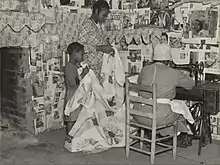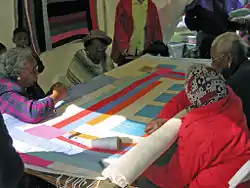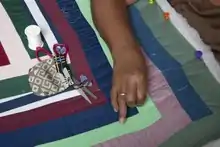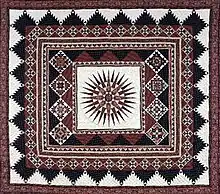Quilts of Gee's Bend
The quilts of Gee's Bend are quilts created by a group of women and their ancestors who live or have lived in the isolated African-American hamlet of Gee's Bend, Alabama along the Alabama River. The quilts of Gee's Bend are among the most important African-American visual and cultural contributions to the history of art within the United States. Arlonzia Pettway, Annie Mae Young and Mary Lee Bendolph are among some of the most notable quilters from Gee's Bend. Many of the residents in the community can trace their ancestry back to slaves from the Pettway Plantation.[1] Arlonzia Pettway can recall her grandmother's stories of her ancestors, specifically of Dinah Miller, who was brought to the United States by slave ship in 1859.[2]

History
Just southwest of Selma, in the Black Belt of Alabama, Gee's Bend (officially called Boykin) is an isolated, rural community of about seven hundred inhabitants. The area is named after Joseph Gee, a landowner who came from North Carolina and established a cotton plantation in 1816 with his seventeen slaves. In 1845, the plantation was sold to Mark H. Pettway. Many members of the community still carry the name. After emancipation, many freed slaves and family members stayed on the plantation as sharecroppers.

In the 1930s, Gee's Bend saw a significant shift in their community, as a merchant who had given credit to the families of the Bend died, and the family of this merchant collected on debts owed to him in brutal fashion. These indebted families watched as their food, animals, tools and seed were taken away, and the community was saved by the distribution of Red Cross rations. Much of the land of this area was sold to the federal government and the Farm Security Administration, and those organizations set up Gee's Bend Farms, Inc., a pilot project that was a cooperative-based program intended to help sustain the inhabitants of the area. The government sold tracts of land to the families of the bend, thus giving the Native and African American population control over the land, which at the time was still rare. The community of Gee's Bend was also the subject of several Farm Security Administration photographers, like Dorothea Lange. During the latter half of the Great Depression the inhabitants of the area faced challenges as farming practices became increasingly mechanized, and consequently, a large portion of the community left.[3]
However, many inhabitants of the community stayed. In 1949, a U.S Post Office was established in Gee's Bend. In 1962, the ferry service, one of the only accesses into Gee's Bend, was eliminated, contributing to the community's isolation. Among other effects, this hindered residents’ ability to register to vote. Ferry service was not restored until 2006.[4]
From the 1960s onward, the community of Gee's Bend, as well as the Freedom Quilting Bee in nearby Alberta, gained attention for the production of their quilts. Folk art collector, historian, and curator William Arnett brought further attention to this artistic production with his Souls Grown Deep Foundation in Atlanta, Georgia. Arnett organized an exhibition titled, "The Quilts of Gee's Bend", which first debuted in 2002 at the Museum of Fine Arts in Houston and later travelled to a dozen other locations across the country. The exhibition featured sixty quilts created by forty-five artists. [5]This exhibition brought fame to the quilts. Arnett's management of Gee's Bend quilts was not always viewed positively. In 2007, two Gee's Bend quiltmakers: Annie Mae Young and Loretta Pettway filed lawsuits saying that Arnett cheated them out of thousands of dollars from the sales of their quilts.[6] The lawsuit was resolved and dismissed without comment from lawyers on either side in 2008. [7]
Despite this former controversy, Arnett's foundation Souls Grown Deep Foundation continues to collect and organize exhibitions for Gees Bend Quilts. [8]The foundation manages multiple campaigns to support Gees Bend Quiltmakers. They aim to provide documentation, marketing, and fund-raising, as well as education and opportunity for quiltmakers. The foundation also involved in a multi-year campaign with the Artists Rights Society to gain intellectual property rights for the artists of Gee's Bend.[9]
Quilts
The quilting tradition in Gee's Bend goes back beyond the 19th century and may have been influenced in part by patterned Native American textiles and African textiles. African-American women pieced together strips of cloth to make bedcovers. Throughout the post-bellum years and into the 20th century, Gee's Bend women made quilts to keep themselves and their children warm in unheated shacks that lacked running water, telephones and electricity. Along the way they developed a distinctive style, noted for its lively improvisations and geometric simplicity.[1] Many of the quilts are a departure from classical quilt making, bringing to mind a minimalist quality. This could also have been influenced by the isolation of their location, which necessitated using whatever materials were on hand, often recycling from old clothing and textiles.[10]
The quilts have been exhibited at the Museum of Fine Arts Houston, the Indianapolis Museum of Art, the Philadelphia Museum of Art, the Tacoma Art Museum, and the Whitney Museum of American Art, among others. The reception of the work has been mostly positive, as Alvia Wardlaw, curator of Modern and Contemporary Art at the Museum of Fine Arts, Houston wrote, "The compositions of these quilts contrast dramatically with the ordered regularity associated with many styles of Euro-American quiltmaking. There's a brilliant, improvisational range of approaches to composition that is more often associated with the inventiveness and power of the leading 20th-century abstract painters than it is with textile-making".[10] The Whitney venue, in particular, brought a great deal of art-world attention to the work, starting with Michael Kimmelman's 2002 review in The New York Times which called the quilts "some of the most miraculous works of modern art America has produced" and went on to describe them as a version of Matisse and Klee arising in the rural South.[11] Comparable effect can be seen in the quilts of isolated individuals such as Rosie Lee Tompkins, but the Gee's Bend quilters had the advantage of numbers and backstory.

In 2003, 50 quilt makers founded the Gee's Bend Collective, which is owned and operated by the women of Gee's Bend.[1] Every quilt sold by the Gee's Bend Quilt Collective is unique and individually produced. In recent years, members of the Collective have traveled nationwide to talk about Gee's Bend's history and their art. Many of the ladies have become well known for their wit, engaging personality and, in some cases, singing abilities.

In 2015, Gee's Bend quilters Mary Lee Bendolph, Lucy Mingo, and Loretta Pettway were joint recipients of a National Heritage Fellowship awarded by the National Endowment for the Arts, which is the United States government's highest honor in the folk and traditional arts.[12]
See also
References
- Wallach, Amei (October 2006). "Fabric of Their Lives". Smithsonian Magazine. Retrieved March 23, 2018.
- Halper, Vicki; Douglas, Diane, eds. (2009). Choosing craft : the artist's viewpoint. Chapel Hill: University of North Carolina Press. ISBN 978-0807831199. OCLC 646811437.
- Stephens, Kyes. "The History of Gee's Bend Alabama". Alabama Online University. Auburn University. Archived from the original on March 25, 2015. Retrieved March 8, 2015.
- Dunner, Shermika; Bass, Erin Z. (April 17, 2012). "The Future of Gee's Bend". Deep South Magazine. Retrieved December 5, 2017.
- Duffy, Karen (2007). "Review: [Untitled]". The Journal of American Folklore. 120 (475): 94–95. doi:10.1353/jaf.2007.0008. S2CID 162304552. Retrieved December 17, 2020.
- Dewan, Shaila (July 29, 2007). "Handmade Alabama Quilts Find Fame and Controversy". New York Times. Retrieved December 17, 2020.
- Associated Press, The (August 26, 2008). "Alabama: Quilters Resolve Lawsuit". New York Times. Retrieved December 17, 2020.
- Sheets, Hilarie (November 12, 2018). "Five More Museums Acquire Art From Souls Grown Deep Foundation". New York Times. Retrieved December 17, 2020.
- "Souls Grown Deep Community Partnership". Souls Grown Deep. Souls Grown Deep. Retrieved December 17, 2020.
- "'The Quilts of Gee's Bend': A Showcase of Distinctive Work by African-American Artists". NPR.org. February 4, 2003. Retrieved December 5, 2017.
- Kimmelman, Michael (November 29, 2002). "ART REVIEW: Jazzy Geometry, Cool Quilters". The New York Times. Retrieved November 19, 2017.
- "NEA National Heritage Fellowships 2015". www.arts.gov. National Endowment for the Arts. Retrieved November 19, 2020.
Further reading
- Cooks, Bridget R. (2011). Exhibiting Blackness: African Americans and the American Art Museum. University of Massachusetts Press. ISBN 9781613760062.
- Beardsley, John; Arnett, William; Arnett, Paul; Livingston, Jane (2002). The Quilts of Gee's Bend (1st ed.). Atlanta, GA: Tinwood Books in association with the Museum of Fine Arts, Houston. ISBN 0965376648. OCLC 51172928.
- Beardsley, John; Arnett, William; Arnett, Paul; Livingston, Jane (2002). Gee's Bend: The Women and Their Quilts. Tinwood Books in association with the Museum of Fine Arts, Houston. ISBN 978-0971910409.
- Creation Story: Gee's Bend Quilts and the Art of Thornton Dial. Frist Center for the Visual Arts. 2012. ISBN 9780826518804.
- Documentary video on the Gee’s Bend quilters and a double-CD of Gee’s Bend Gospel Music from 1941 and 2002.
- Duncan, Sally Anne (February 2005). "From Cloth to Canvas: Reinventing Gee's Bend Quilts in the Name of Art". Museum Anthropology. 28 (1): 19–34. doi:10.1525/mua.2005.28.1.19.
- Gee's Bend: The Architecture of the Quilt. Atlanta: Tinwood Books. 2006. ISBN 9780971910478.
- Herman, Brandon L. (April 16, 2015). "The Quilts of Gee's Bend: How Great Art Gets Lost". The Journal of Modern Craft. 2 (1): 9–15. doi:10.2752/174967809X416233. S2CID 191470782. Retrieved December 17, 2020.
- Mary Lee Bendolph, Gee's Bend Quilts, and Beyond. Tinwood Books. 2006. ISBN 9780971910485.
- McKissack, Pat; Cabrera, Cozbi (2008). Stitchin' and Pullin': A Gee's Bend Quilt. New York: Random House.
- Scheper-Hughes, Nancy (September 22, 2003). "Anatomy of a quilt: The Gees' Bend Freedom Quilting Bee". Anthropology Today. 19 (4): 15–21. doi:10.1111/1467-8322.00203. Retrieved December 17, 2020.
- Sohan, Vanessa Kraemer (2015). "'But a Quilt Is More': Recontextualizing the Discourse(s) of Gee's Bend Quilts". College English. 77 (4): 294–316. JSTOR 24240050. Retrieved December 17, 2020.
- Wilder, Elyzabeth Gregory (November 25, 2008). Gee's Bend. Samuel French, Inc. ISBN 978-0573663673.
External links
- "The Quilts of Gee's Bend in Context". Auburn University, Women's Studies. Archived from the original on April 19, 2019.
- Craft in America, Season 6, episode: INDUSTRY. PBS documentary series about the craft movement in the United States. This episode includes a segment about the Gee's Bend Quilters, which begins at approximately 4:10, concludes at about 17:10.
- "Gee's Bend Quiltmakers". Souls Grown Deep. Souls Grown Deep Foundation. Retrieved December 17, 2020.
- Marvar, Alexandra (October 29, 2018). "Can You Copyright a Quilt?". The Nation. Retrieved December 17, 2020.
- "The Quilts of Gee's Bend". Souls Grown Deep. Souls Grown Deep Foundation. Retrieved December 17, 2020.
